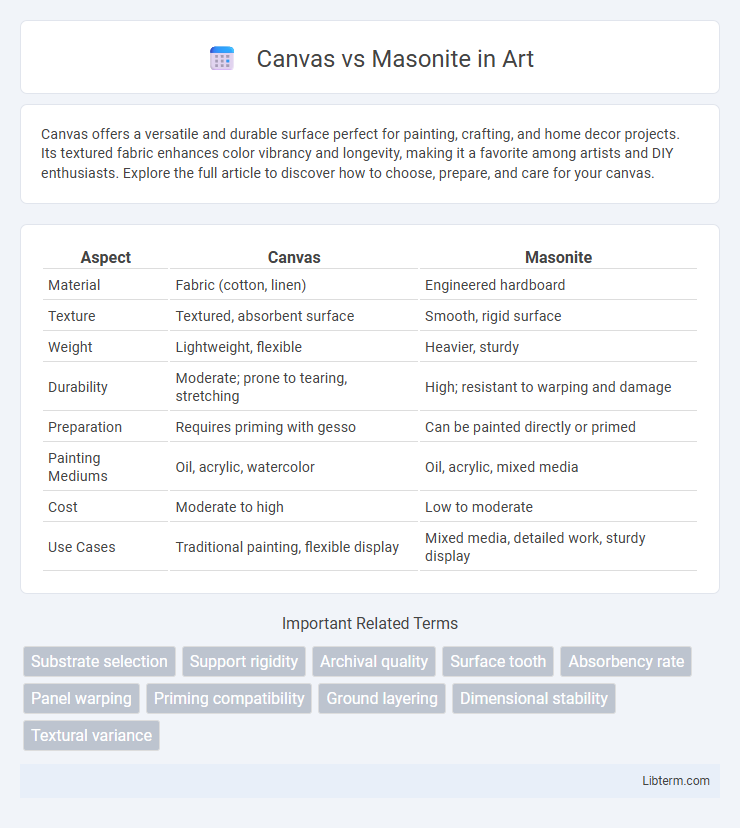Canvas offers a versatile and durable surface perfect for painting, crafting, and home decor projects. Its textured fabric enhances color vibrancy and longevity, making it a favorite among artists and DIY enthusiasts. Explore the full article to discover how to choose, prepare, and care for your canvas.
Table of Comparison
| Aspect | Canvas | Masonite |
|---|---|---|
| Material | Fabric (cotton, linen) | Engineered hardboard |
| Texture | Textured, absorbent surface | Smooth, rigid surface |
| Weight | Lightweight, flexible | Heavier, sturdy |
| Durability | Moderate; prone to tearing, stretching | High; resistant to warping and damage |
| Preparation | Requires priming with gesso | Can be painted directly or primed |
| Painting Mediums | Oil, acrylic, watercolor | Oil, acrylic, mixed media |
| Cost | Moderate to high | Low to moderate |
| Use Cases | Traditional painting, flexible display | Mixed media, detailed work, sturdy display |
Introduction: Canvas vs Masonite
Canvas and Masonite serve distinct purposes in art and construction, with canvas predominantly used as a durable painting surface made from tightly woven fabric, while Masonite is a type of engineered hardboard composed of pressed wood fibers favored for its smooth, rigid panels. Artists choose canvas for its flexibility, texture, and traditional compatibility with oil and acrylic paints, whereas Masonite provides a stable, flat surface ideal for mounting artwork, cabinetry, or furniture backing. Comparing canvas and Masonite involves evaluating factors such as durability, texture, cost, and application to determine the best material for specific creative or structural needs.
Material Composition Overview
Canvas is typically made from woven cotton or linen fibers, prized for its durability and flexibility, commonly used in art and upholstery. Masonite, a type of hardboard, is manufactured from compressed wood fibers bonded with resin under high heat and pressure, resulting in a dense, smooth surface ideal for painting or construction. The fundamental difference lies in Canvas being a fabric material, whereas Masonite is a rigid engineered wood product.
Surface Texture and Feel
Canvas features a textured, woven surface that provides a natural, slightly rough feel ideal for acrylic and oil painting, allowing paint to grip effectively. Masonite offers a smooth, hard surface with a fine texture that supports detailed work and precise brushstrokes, especially suited for ink, acrylic, and tempera. Artists often choose canvas for its absorbency and tactile quality, while masonite is preferred for durability and a sleek, consistent surface.
Durability and Longevity
Canvas is a flexible, fabric-based material known for its moderate durability and resistance to wear, typically lasting several years with proper care, but it can be prone to tearing and weather damage over time. Masonite, a type of hardboard made from compressed wood fibers, offers superior durability, impact resistance, and longevity, often maintaining structural integrity for decades when kept dry and well-maintained. For applications requiring long-lasting, rigid surfaces, Masonite outperforms canvas, especially in environments where durability against physical and environmental stress is critical.
Painting Techniques Compatibility
Canvas offers superior flexibility and breathability, making it ideal for oil and acrylic painting with various techniques such as impasto, glazing, and detailed brushwork. Masonite, a rigid hardboard, accommodates heavy layering and textural techniques but may limit the absorption and drying time compared to canvas. Artists often choose canvas for its adaptability to wet-on-wet and blending methods, while Masonite supports precise, hard-edged techniques and mixed media applications.
Preparation and Priming Needs
Canvas requires minimal preparation and generally only needs to be stretched and lightly primed with gesso to create an ideal painting surface. Masonite demands more extensive preparation, often involving sanding to smooth the surface, followed by the application of multiple primer coats to ensure proper adhesion and prevent paint absorption. Proper priming on both materials enhances durability and paint vibrancy, but Masonite's denser surface necessitates a heavier priming approach compared to canvas.
Weight and Portability
Canvas is significantly lighter and more flexible than Masonite, making it easier to transport and handle during painting sessions or art classes. Masonite, a dense and rigid hardboard, is considerably heavier and less portable, which can limit its convenience for artists who need to move their work frequently. The weight difference directly impacts the ease of storage and mobility, favoring canvas for artists who prioritize lightweight materials.
Cost Comparison
Canvas generally costs less upfront compared to Masonite, making it a budget-friendly option for art and crafting projects. Masonite panels, made from compressed wood fibers, tend to have a higher initial price but offer greater durability and longevity. When evaluating total cost, Canvas may require more frequent replacement, whereas Masonite's sturdiness can provide better long-term value despite its higher initial expense.
Popular Uses and Applications
Canvas is widely used for painting, printing, and upholstery due to its durable, flexible fabric that holds paint and ink well. Masonite, a type of hardboard made from wood fibers, is popular in construction, cabinetry, and furniture-making for its smooth surface and structural strength. Both materials serve distinct applications, with canvas favored in artistic and textile fields while Masonite excels in building and finishing projects.
Choosing the Right Surface
Choosing the right surface between Canvas and Masonite depends on the artwork's medium and desired texture. Canvas offers a flexible, breathable texture ideal for oils and acrylics, enhancing paint adhesion and durability. Masonite provides a smooth, rigid surface perfect for detailed work and mixed media, resisting warping and offering longevity.
Canvas Infographic

 libterm.com
libterm.com